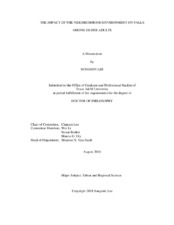| dc.description.abstract | Falls are substantial barriers to walking outside and outdoor physical activity among older adults. Although health and behavioral risk factors for falls were well explored, neighborhood environmental factors for the risk of falling remain poorly understood. The over-arching goal of this dissertation is to understand the heterogeneity of falls in relation to neighborhood environmental features through multifaceted research approaches. This dissertation contains three independent studies, consisting of one systematic review paper and two quantitative studies with one as a cross-sectional study at the neighborhood level and another as a longitudinal study at the individual level.
The first systematic review paper was to examine the risk factors of indoor and outdoor falls in relation to biological/ health, behavior, and socio-economic status through a systematic review. Findings from this study showed that the occurrence of indoor falls tended to be associated with being female and being frail, while outdoor falls are more common among males and those who are physically active.
The second study explored the characteristics of neighborhood environments associated with fall injuries reported to emergency medical services (EMS) from 2011-2014 in the city of San Antonio (TX, USA) at the census tract level. The study showed that neighborhoods with higher residential density with a higher vacancy rate were associated with increased counts of fall injuries. Neighborhoods with higher residential stability captured as the percent of those who lived in the same house as the previous year were shown to be associated with a decreased count of fall injuries.
Finally, the third study used data from the National Health and Aging Trends Study (NHATS). This prospective study examined prospective associations of changes in environmental perceptions (e.g., street conditions, walking surfaces, and physical disorders) with changes in fall occurrence through a longitudinal study. The results showed that safe and well-maintained outdoor environments helped prevent falls among those older adults who actively engage in outdoor activities.
In the conclusion, the findings of this dissertation have underscored the importance of studies examining the risk factors of falls and fall prevention in relation to neighborhood environmental and policy interventions. Thus, environmental interventions to reduce the risk of falling should be considered by public health professionals, gerontologists, environmental psychologists, and urban planners interested in helping older adults reduce fall incidents. | en |


